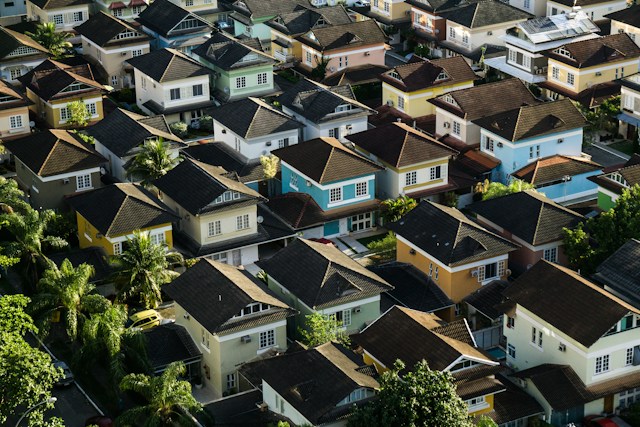In the ever-evolving landscape of the real estate industry, the transformation of underutilized commercial properties is becoming a key focus area. As cities expand and the demands of the local community shift, there is a growing need to transform these spaces into assets that provide value and contribute to community development. In this article, we will examine strategies to breathe new life into underutilized commercial properties and explore the benefits and challenges associated with repurposing these spaces.
1. Repurposing Commercial Spaces into Residential Areas
The conversion of commercial properties to residential spaces is one of the most prevalent strategies in the real estate industry. This approach is often seen in cities where there is a shortage of housing, and an abundance of underused office buildings.
A voir aussi : What are the implications of the gig economy on residential real estate demand?
Repurposing involves transforming these buildings into residential units, such as apartments or condominiums. This strategy not only addresses the housing shortage but also revitalizes neighborhoods, enhancing their appeal to potential residents. Repurposing also brings about the opportunity to redesign the space, making it more environmentally friendly or modern.
However, this kind of conversion is not without its challenges. Zoning regulations, renovation costs, and community acceptance are all factors that need to be considered. But with careful planning, creative design, and engagement with local stakeholders, repurposing can turn underutilized commercial spaces into vibrant residential communities.
Lire également : How to assess the viability of converting office spaces into co-living units?
2. Converting Commercial Real Estate into Community-Centric Spaces
Another strategy for revitalizing underutilized commercial real estate is to convert these properties into community-centric spaces. These conversions may include community centers, libraries, schools, art galleries, or local markets. This strategy not only repurposes the space but also contributes to community development.
Community-centric spaces can serve as hubs for local activities and events, fostering social cohesion and enhancing the area’s vibrancy. They can also stimulate local economies by attracting tourists or providing spaces for small businesses.
However, just like residential conversions, these projects require careful planning and community engagement. Engaging with local residents from the outset can help ensure the space meets community needs and is well received.
3. Building Adaptive Reuse in Commercial Real Estate
Adaptive reuse refers to the practice of repurposing buildings for uses other than those originally intended. This strategy can be an effective way to revitalize underutilized commercial real estate, without the need for large-scale redevelopment projects.
Adaptive reuse projects can range from transforming old factories into trendy lofts, converting warehouses into restaurants or boutiques, or turning office buildings into co-working spaces.
The potential benefits of adaptive reuse are significant. It can help preserve historic buildings, reduce construction waste, promote sustainability, and stimulate economic development.
However, adaptive reuse can also be complex, requiring careful planning and skilled design. Understanding the building’s history, structure, and the needs of the local community are all crucial components of a successful adaptive reuse project.
4. Implementing Mixed-Use Development in Commercial Real Estate
Mixed-use development is another strategy that can breathe new life into underutilized commercial real estate. This approach involves combining residential, commercial, and sometimes even industrial uses within the same building or development.
The idea behind mixed-use development is to create dynamic, vibrant neighborhoods where people can live, work, and play all within the same area. This can not only revitalize underutilized commercial properties, but also contribute to reducing urban sprawl, promoting walkability, and fostering a sense of community.
However, mixed-use development can be complex and requires careful planning and design to ensure the various uses coexist harmoniously. It also requires policies that support mixed-use development, including flexible zoning regulations and incentives for developers.
5. Leveraging Technology to Enhance Commercial Real Estate Utilization
Technology can play a crucial role in revitalizing underutilized commercial real estate. Technological advancements like virtual reality, 3D modeling, and data analytics can provide valuable insights into how best to repurpose a space, enhance its functionality, and improve its marketability.
For instance, virtual reality and 3D modeling can help visualize potential alterations and understand how they would impact the space’s use and appeal. Data analytics, on the other hand, can provide insights into market trends, potential tenant preferences, and profitability projections, which can inform the repurposing strategy.
While leveraging technology requires investment, the potential benefits, such as improved decision-making, cost savings, and increased profitability, can make it a valuable tool in the process of revitalizing underutilized commercial real estate.
6. Incentivizing Repurposing through Government Policies and Tax Credits
Government policies and tax credits play a significant role in encouraging the revitalization of underutilized commercial real estate. Local governments possess the ability to stimulate change and guide property owners towards effective repurposing strategies.
Governmental incentives such as tax credits can make repurposing projects more financially viable, especially for smaller property owners. Such incentives can offset some of the costs associated with repurposing and encourage more real estate developers and owners to consider this approach.
For example, some cities offer tax credits for developments that aim to provide affordable housing. This is especially beneficial in areas where there is a housing crisis. Other incentives may include tax credits for sustainable development or for preserving historic buildings.
In addition to tax incentives, local governments can also aid revitalization efforts by revising zoning restrictions, simplifying the permitting process, and offering technical assistance to property owners. These initiatives can reduce barriers to repurposing and stimulate more innovative use of commercial properties.
However, such incentives require careful implementation to ensure they are targeted effectively and yield the desired outcomes. It’s also important for local governments to engage with stakeholders, including property owners, potential tenants, and local communities, to understand and address their needs and concerns.
7. Embracing the Shift towards Remote Work – Office to Residential Conversions
The ongoing trend of remote work has left many office buildings partially or fully vacant. This presents an opportunity for office to residential conversions. Turning office spaces into residential units can address housing shortages, particularly in urban areas where there is a high demand for homes.
In addition to providing housing, these conversions can breathe new life into vacant office spaces, transforming them into vibrant, bustling places that contribute positively to community life. They can also help property owners to maintain or even increase the value of their properties in the long term.
However, this strategy requires careful planning to ensure that the converted spaces meet residential standards and provide a comfortable living environment. This includes considering factors such as natural light, ventilation, privacy, and accessibility, amongst others.
Moreover, it’s crucial to consider the potential impact on the local community and infrastructure. For instance, converting office buildings into residential units could increase the demand for local services and amenities, such as schools, parks, and retail outlets.
Taking these factors into account, office to residential conversions can be a highly effective way to utilize underutilized commercial real estate, while also responding to evolving societal trends and needs.
Conclusion: The Future of Commercial Real Estate Lies in Innovative Repurposing
The strategies outlined in this article present a broad array of opportunities for revitalizing underutilized commercial real estate. From residential or community-centric conversions, adaptive reuse and mixed-use development, to leveraging technology and government incentives – all these strategies can turn underused commercial properties into assets that provide value, contribute to community development, and respond to societal needs.
Of course, each strategy comes with its own set of challenges and requires careful planning, creative design, and engagement with stakeholders. But with the right approach, underutilized commercial properties can be transformed into spaces that serve the community, stimulate local economies, and preserve the architectural heritage.
As we move forward in the 21st century, the future of commercial real estate lies in innovative repurposing. The ability to adapt and transform underused spaces will be key to ensuring the sustainability and vibrancy of our cities. Property owners, developers, local governments, and communities all have a role to play in this exciting process. With collaboration, creativity, and forward-thinking, we can reimagine and revitalize our commercial landscapes.






